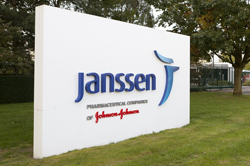By Jan Eastgate,
President CCHR International
The Mental Health Industry Watchdog
June 26, 2019
Citizens Commission on Human Rights (CCHR) is concerned that President Trump is being misled about a nasal spray depression drug, esketamine (Spravato) being the answer to veteran suicides. The president offered to help Veterans Affairs secretary Robert Wilkie negotiate the price of the new drug with its manufacturer, Janssen, a subsidiary of Johnson & Johnson (J&J)—a company that has paid $2.2 billion in criminal and civil fines to the Department of Justice over questionable marketing and selling of its antipsychotic, risperidone, and other drugs off-label.[1] Such negotiations may do more harm than good.
For example, President Trump has declared the opioid crisis a public health emergency,[2] yet J&J is allegedly one of the companies that helped fuel this crisis. Oklahoma Attorney General Mike Hunter claims in a current trial that J&J’s Janssen unit caused a health crisis under the public nuisance theory of law. A star witness in the trial, Dr. Andrew Kolodny, co-director of opioid policy research at the Heller School for Social Policy and Management at Brandeis University in Waltham, Massachusetts, told a state judge that J&J “pressed doctors to prescribe its painkillers even as the potentially fatal addictive threat posed by the drugs became clear more than a decade ago.”[3]
The President has been given the erroneous idea that the nasal spray may cause a drop in the suicides.[4] However, the drug hasn’t been proven to reduce the risk of suicide and has other issues, according to a Bloomberg News report.[5] In fact, there are reports of esketamine inducing “psychosis-like” effects.[6]
Esketamine carries with it potential serious risks because of its molecular similarity to ketamine, a “club” and “date rape” drug that can cause disassociation, meaning victims enter a state in which they feel as if their mind and body aren’t connected. [7]
Esketamine comes with a prominent warning: “Patients are at risk for dissociative or perceptual changes after administration” and it has the potential, like ketamine, to be abused.[8] The dissociation can include difficulty with judgment, attention and thinking.[9] According to one scientific study, esketamine was associated with cognitive performance decline.[10]
CCHR applauds any White House and Congressional action to curb suicides among the military and veterans but says they are misled if they think that dosing the brain through a nasal spray is conducive to healing depression. The idea that esketamine can treat depression is purely hypothetical,[11] essentially making veterans, already subjected to suicide-inducing antidepressants and electroshock treatment, virtual guinea pigs. In March 2019, the VA announced it would use the nasal spray for “treatment-resistant depression.”[12]

Dr. Jess Fiedorowicz, director of the Mood Disorders Center at the University of Iowa and a member of the FDA advisory committee that reviewed esketamine, described its benefit as “almost certainly exaggerated” after hearing the evidence. He considered Janssen’s study design flawed.
Dr. Jess Fiedorowicz, director of the Mood Disorders Center at the University of Iowa and a member of the Food and Drug Administration (FDA) advisory committee that reviewed the drug, described its benefit as “almost certainly exaggerated” after hearing the evidence. He considered Janssen’s study design flawed.[13]
Kaiser Health News (KHN) said Janssen presented no information about the safety of esketamine or long-term use, reporting: “The FDA approved it anyway, despite deep misgivings expressed at its day-long review meeting and in the agency’s own briefing materials, according to public recordings, documents and interviews with participants.”
KHN’s investigation has found:[14]
- Janssen provided just one successful short-term, double-blind trial of esketamine. Two other trials it ran to test efficacy fell short. Six participants died during clinical studies, three by suicide, compared to no suicides in the control group. Janssen and the FDA dismissed the deaths as unrelated to the drug.
- Kim Witczak, the FDA expert committee’s consumer representative, found Janssen’s conclusion about the suicides unsatisfying. “I just feel like it was kind of a quick brush-over,” Witczak said. She voted against the drug.
- The single positive efficacy trial also showed only a 4-point improvement in depression symptoms compared with the placebo treatment on a 60-point scale some clinicians use to measure depression severity.
- The FDA has lowered the bar for “treatment-resistant depression.” Initially, for inclusion, trial participants would have had to have failed two classes of oral antidepressants. Forty-nine of the 227 people who participated in Janssen’s only successful efficacy trial had failed just one class of oral antidepressants.
- The FDA typically requires that companies provide at least two clinical trials demonstrating the drug’s efficacy, “each convincing on its own.” To reach the two-trial threshold, however, the FDA broke its precedent for psychiatric drugs and allowed the company to count a trial conducted to study a different topic: relapse and remission trends.
- The FDA expert panel cleared the drug according to the evidence that the agency and Janssen had determined was sufficient. Yet, Steven Meisel, the system director of medication safety for Fairview Health Services based in Minneapolis stated: “I don’t think that we really understand what happens when you take this week after week for weeks and months and years.” [15]
KHN reported: “Esketamine’s trajectory to approval shows — step by step — how drugmakers can take advantage of shortcuts in the FDA process with the agency’s blessing and maneuver through safety and efficacy reviews to bring a lucrative drug to market.”
Adding to the Opioid Crisis?
Esketamine is used in combination with oral antidepressants.[xvi] As stated, chemically, esketamine is very similar to ketamine, an anesthetic that was developed in the 1960s and was used to operate on soldiers during the Vietnam War. It’s also been used as an animal tranquilizer.[xvii] Additionally, Ketamine is used “off label” to treat depression as its alleged antidepressant effects are theorized to be from it activating opioid receptors.[18]
Three doctors—Marco A. Ramos, MD, PhD, J. Wesley Boyd, MD, PhD, and Michael D. Alpert, MD, the latter a psychiatrist and clinical faculty at Harvard Medical School—wrote a commentary on esketamine in Vice in May 2019, stating: “Because ordinary ketamine is generic, Johnson & Johnson simply isolated one of the two molecules in regular ketamine so that it qualified as ‘new.’ The reality is that we don’t know whether esketamine is more or less effective than regular ketamine because there have been no head-to-head trials between the two.[19]
“My concern about this [ketamine] compound is that it is a disguised form of opiates,” said Dr. Mark George, a professor of psychiatry, radiology and neurosciences at the Medical University of South Carolina. “I’m alarmed that there is pretty clear evidence [that] the way ketamine works is through the opioid system.”[20]
“In the wake of the opioid crisis, perhaps the biggest worry is that loosening the reins too much on the use of ketamine and similar drugs could lead to a new abuse crisis,” Bloomberg Business Week reported.[21] [Emphasis added]
“Club” and “Date Rape” Drug Link
 Ketamine is known for its abuse potential as a “club drug.” Street users sometimes take doses large enough to enter what’s known as a “K hole,” a state in which they’re unable to interact with the world around them.[22]
Ketamine is known for its abuse potential as a “club drug.” Street users sometimes take doses large enough to enter what’s known as a “K hole,” a state in which they’re unable to interact with the world around them.[22]
Medical News Today reports that victims of ketamine “may lose consciousness or be confused and compliant. They might not remember what happened while under the influence of the drug. Unlike most other date rape drugs, ketamine acts almost immediately. A victim may not have time to realize they have been drugged.”[23]
David Olson, an assistant professor of chemistry, biochemistry and molecular medicine at the University of California, Davis, warns that ketamine-like drugs are “dirty,” meaning they likely hit a variety of targets in the brain.[24]
Add Brain Damaging Electroshock
Ketamine is also used as an anesthetic in electroshock treatment (ECT).[25] The VA reports hundreds of veterans are given electroshock every year.[26] ECT is said to be used for “treatment-resistant” depression, just as eskestimine is now being recommended. The numbers of vets being electroshocked do not include those being given it in private or non-contracting VA institutions. In 2008 there were at least 75 locations in the VA medical centers network that delivered electroshock.[27] By October 2015, this had almost doubled, with 140 of the VHA’s facilities—approximately 49 percent—delivering ECT to patients, on both an inpatient and outpatient basis.[28]
The FDA has never required ECT device manufacturers to produce Congressional-mandated pre-marketing applications (PMAs) with clinical trials to prove the safety and efficacy of the high-risk (Class III) ECT devices. Instead, in December 2018, it reduced the classification to a lower risk of Class II, circumventing the PMA, despite thousands of submissions opposing this.[29]
In 2015, Dr. Matthew Rudorfer, an associate director at the National Institute of Mental Health (NIMH), who oversees grants for ECT research, told The New York Times that electroshock clinical trials would be “too expensive” for the ECT manufacturers.[30]
Rudorfer, a government official, wrote about ketamine and ECT in a commentary he made with a prolific ECT proponent, Charles Kellner and other psychiatrists, some of whom had a conflict of interest with an ECT device manufacturer.[31]
Rudorfer sat as a member of the FDA expert committee reviewing esketamine and voted to clear the drug, concluding that the “benefits outweighed the risks.”[32]
A History Worth Checking to Safeguard Veterans
The FDA is approving Janssen drugs and the VA is paying for them, despite the company’s controversial history, including paying out millions of dollars to settle lawsuits about its failure to warn that its antipsychotic, Risperdal, can cause gynecomastia (female breast growth) in young boys administered the drug. One youth was awarded $70 million in damages after alleging Risperdal caused him to grow size 42D breasts.[33]
- In 2012, the manufacturer paid $158 million to settle a Risperdal lawsuit brought by the state of Texas. Texas had sued the drug maker for defrauding the state’s Medicaid program by promoting Risperdal for the treatment of children whose problems had nothing to do with schizophrenia—in other words, for uses not approved by the FDA. In August 2012, the company also agreed to pay $181 million to settle legal actions that had been brought by 36 other states over improperly marketing.[34]
- Johnson & Johnson and Boston Scientific are among seven companies paying nearly $8 billion to resolve the claims of more than 100,000 women about a surgical mesh the companies manufacture.[35] As of 2018, the FDA had received reports of more than 10,000 complaints of serious injury and nearly 80 deaths linked to the pelvic surgical mesh the FDA approved in 2002 for use as a class II moderate-risk device.[36] For years, women and legal advocates tried to persuade the FDA that the pelvic mesh implant caused harm.[37] In April 2019, Washington State Attorney General Bob Ferguson announced that J&J would pay $9.9 million to avoid going to trial for misrepresentations and failure to include serious risks in the instructions and marketing materials for surgical mesh devices.[38]
Yet negotiations are planned to get the company to reduce the costs of its esketamine, a drug with potential risks and without clinical proof that it can systematically reduce veteran suicides and for which the long-term effects are unknown.
We are doing a great disservice to veterans and anyone in the military when drugs and ECT are recommended for ‘treatment-resistant depression’ (TRD), PTSD and other issues related to military service. TRD is an invented term that can mislead consumers into thinking the problem is theirs and not the failure of treatments given them. With esketamine, it seems that with each new and allegedly improved treatment, the safety of veterans is not at the top of the list of major concerns. The FDA keeps giving companies producing such treatments a license to profit at the expense of our veterans’ sanity, health and lives.
References:
[1] https://www.consumersafety.org/legal/risperdal-lawsuit/
[2] https://www.whitehouse.gov/opioids/
[3] “J&J ‘Did Everything’ to Push Opioids, Oklahoma Witness Says,” Bloomberg, 11 June 2019, https://www.bloomberg.com/news/articles/2019-06-11/johnson-johnson-fueled-opioid-crisis-trial-witness-testifies
[4] https://www.bloomberg.com/opinion/articles/2019-06-13/trump-offer-to-negotiate-j-j-depression-drug-for-vets-is-all-show
[5] Ibid.
[6] https://www.ucl.ac.uk/news/2009/nov/heavy-ketamine-use-affects-short-term-memory
[7] https://www.medicalnewstoday.com/articles/320409.php; https://www.bloomberg.com/news/features/2019-02-05/ketamine-could-soon-be-used-to-treat-suicidal-ideation
[8] https://www.rxlist.com/spravato-drug.htm
[9] “What Makes the Ketamine-Based Drug for Depression So Different?,” Live Science, 6 Mar. 2019, https://www.livescience.com/64937-ketamine-nasal-spray-depression.html
[10] Randall L. Morrison, et al., “Effect of intranasal esketamine on cognitive functioning in healthy participants: a randomized, double-blind, placebo-controlled study,” Psychopharmacology (Berl). 2018; 235(4): 1107–1119, https://www.ncbi.nlm.nih.gov/pmc/articles/PMC5869899/
[11] Op. cit., Live Science
[12] https://www.va.gov/opa/pressrel/pressrelease.cfm?id=5220
[13] “FDA Overlooked Red Flags In Drugmaker’s Testing of New Depression Medicine,” Kaiser Health News, 11 June 2019, https://khn.org/news/fdas-approval-of-new-depression-drug-overlooked-red-flags-in-its-testing/
[14] Ibid.
[15] Ibid.
[16] https://www.statnews.com/2019/02/20/psychiatry-awaits-esketamine-with-excitement-hesitation/
[17] https://www.forbes.com/sites/joshuacohen/2019/03/11/esketamine-faces-challenges-in-its-quest-to-be-a-breakthrough-drug-against-suicidal-ideation/#7594b7c035df; https://www.webmd.com/mental-health/news/20170706/ketamine-and-depression-faq
[18] https://www.livescience.com/63457-ketamine-depression-opioid-receptors.html
[19] “Opinion: The New Ketamine-Based Antidepressant Is a Rip-Off: Johnson & Johnson patented a form of the psychedelic with less research and a ridiculous price tag,” Vice, 17 May 2019, https://www.vice.com/en_us/article/pajkjy/opinion-the-new-ketamine-based-antidepressant-is-a-rip-off
[20] Op. cit., Live Science
[21] https://www.bloomberg.com/news/features/2019-02-05/ketamine-could-soon-be-used-to-treat-suicidal-ideation
[22] https://www.bloomberg.com/news/features/2019-02-05/ketamine-could-soon-be-used-to-treat-suicidal-ideation
[23] https://www.medicalnewstoday.com/articles/320409.php
[24] Op. cit., Live Science
[25] https://www.thelancet.com/journals/lanpsy/article/PIIS2215-0366(17)30099-8/fulltext
[26] https://www.prnewswire.com/news-releases/psychologists-support-ban-of-electroshock-treatment-on-military-and-veterans-300462418.html
[27] https://www.madinamerica.com/2015/11/electroshocking-us-veterans-and-their-fetuses/
[28] https://www.einpresswire.com/article/484530759/cchr-says-veterans-deserve-better-than-antidepressants-antipsychotics-and-electroshock
[29] https://www.federalregister.gov/documents/2018/12/26/2018-27809/neurological-devices-reclassification-of-electroconvulsive-therapy-devices-effective-date-of
[30] “F.D.A. is Studying the Risk of Electroshock Devices,” The New York Times, 23 Jan. 2011, http://www.nytimes.com/2011/01/24/business/24shock.html; Susan FitzGerald, “Despite Protests, Shock Treatment Gains New Respect,” Philly.com (Philadelphia Inquirer), 17. Oct. 1998, http://articles.philly.com/1988-10-17/news/26272212_1_ect-mental-patient-harold-sackeim
[31] https://www.ncbi.nlm.nih.gov/pubmed/25511506
[32] “FDA overlooked red flags in drugmaker’s testing of new depression medicine,” Chicago Tribune, 17 June 2019, https://www.chicagotribune.com/sns-tns-bc-med-fda-esketamine-20190617-story.html
[33] https://clearviewpost.com/nationwide-risperdal-lawsuits-shed-light-on-the-patchwork-of-state-laws-that-can-determine-the-value-of-your-life/
[34] https://www.baumhedlundlaw.com/prescription-drugs/risperdal-lawsuit/
[35] https://www.nytimes.com/2019/02/01/business/pelvic-mesh-settlements-lawyers.html
[36] “F.D.A. Halts U.S. Sales of Pelvic Mesh, Citing Safety Concerns for Women,” The New York Times, 16 Apr. 2019, https://www.nytimes.com/2019/04/16/health/vaginal-pelvic-mesh-fda.html; https://www.massdevice.com/fda-bans-boston-sci-coloplast-sales-of-pelvic-mesh/
[37] “F.D.A. Halts U.S. Sales of Pelvic Mesh, Citing Safety Concerns for Women,” The New York Times, 16 Apr. 2019, https://www.nytimes.com/2019/04/16/health/vaginal-pelvic-mesh-fda.html
[38] https://www.atg.wa.gov/news/news-releases/johnson-johnson-will-pay-99-million-failing-disclose-risk-its-surgical-mesh


